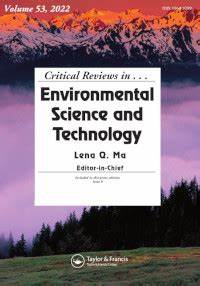Peracetic acid-driven advanced oxidation processes for wastewater treatment: Demystifying organic radicals and non-radical species
IF 13.2
1区 环境科学与生态学
Q1 ENVIRONMENTAL SCIENCES
Critical Reviews in Environmental Science and Technology
Pub Date : 2025-07-18
DOI:10.1080/10643389.2025.2495637
引用次数: 0
Abstract
Peracetic acid (PAA) based advanced oxidation processes (AOPs) have received increasing attention in wastewater treatment. However, it is challenging to identify the radical and/or non-radical species and elucidate the intrinsic interaction mechanisms involved in PAA-based AOPs. This work presents a systematic review of the selective generation mechanisms of radicals (hydroxyl and organic radicals), with a focus on organic radicals, and non-radical species (reactive complexes (RC), high-valent metals (HVM), singlet oxygen (1O2), and electron transfer process (ETP)). Furthermore, we examine various strategies for the precise identification and characterization of radical and/or non-radical species (e.g., quenching, chemical probes, spectroscopy, mass spectrometry, and electrochemical testing), and emphasize existing controversies. Subsequently, we provide an in-depth discussion of the reaction mechanisms between the reactive species and the contaminants/water matrices, as well as the potential for generating halogenated byproducts. Finally, we highlight the challenges and opportunities of the PAA-based AOPs in wastewater treatment, aiming to inspire future research endeavors that promote the practical application of PAA-based AOPs in wastewater treatment.废水处理中过氧乙酸驱动的高级氧化工艺:揭开有机自由基和非自由基的神秘面纱
过氧乙酸(PAA)基深度氧化工艺(AOPs)在废水处理中受到越来越多的关注。然而,确定自由基和/或非自由基种类以及阐明paas基AOPs的内在相互作用机制具有挑战性。本文对自由基(羟基自由基和有机自由基)的选择性生成机制进行了系统的综述,重点介绍了有机自由基和非自由基(反应性配合物(RC)、高价金属(HVM)、单线态氧(1O2)和电子转移过程(ETP))。此外,我们研究了各种用于精确鉴定和表征自由基和/或非自由基物种的策略(例如,淬火,化学探针,光谱,质谱和电化学测试),并强调了现有的争议。随后,我们深入讨论了反应物质与污染物/水基质之间的反应机制,以及产生卤化副产物的可能性。最后,我们强调了paas基AOPs在废水处理中的挑战和机遇,旨在启发未来的研究工作,促进paas基AOPs在废水处理中的实际应用。
本文章由计算机程序翻译,如有差异,请以英文原文为准。
求助全文
约1分钟内获得全文
求助全文
来源期刊
CiteScore
27.30
自引率
1.60%
发文量
64
审稿时长
2 months
期刊介绍:
Two of the most pressing global challenges of our era involve understanding and addressing the multitude of environmental problems we face. In order to tackle them effectively, it is essential to devise logical strategies and methods for their control. Critical Reviews in Environmental Science and Technology serves as a valuable international platform for the comprehensive assessment of current knowledge across a wide range of environmental science topics.
Environmental science is a field that encompasses the intricate and fluid interactions between various scientific disciplines. These include earth and agricultural sciences, chemistry, biology, medicine, and engineering. Furthermore, new disciplines such as environmental toxicology and risk assessment have emerged in response to the increasing complexity of environmental challenges.
The purpose of Critical Reviews in Environmental Science and Technology is to provide a space for critical analysis and evaluation of existing knowledge in environmental science. By doing so, it encourages the advancement of our understanding and the development of effective solutions. This journal plays a crucial role in fostering international cooperation and collaboration in addressing the pressing environmental issues of our time.

 求助内容:
求助内容: 应助结果提醒方式:
应助结果提醒方式:


